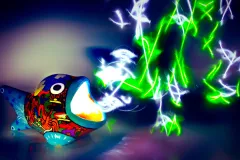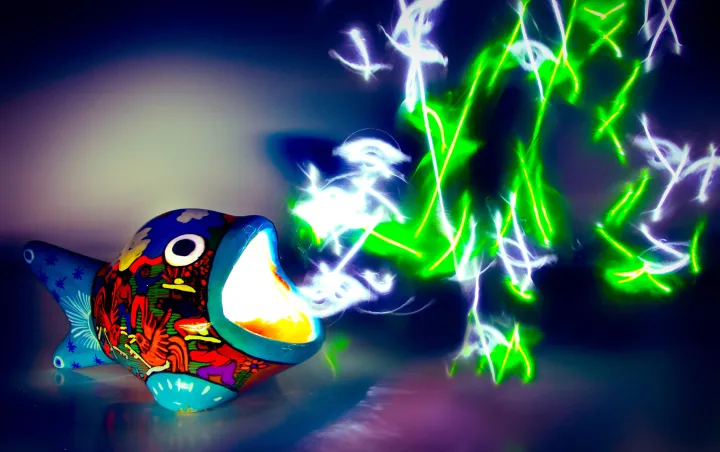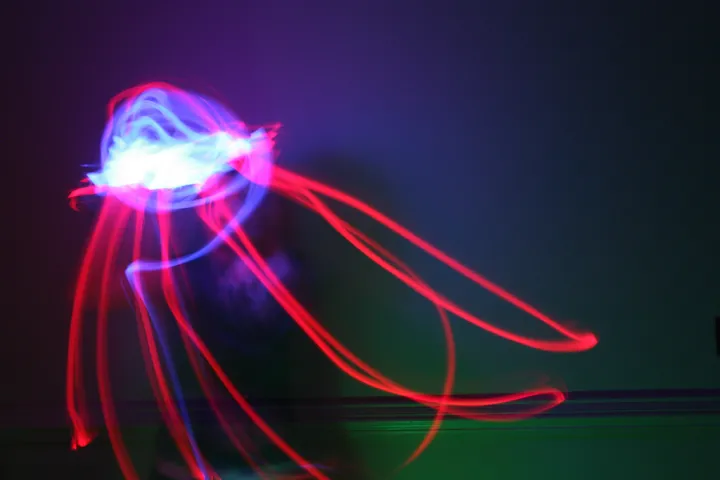Using Light Painting to Teach Bioluminescence

What does a bioluminescent creature that lives more than two miles below the surface of the ocean and a glow stick have in common? More than you think.
In a unique spin on an art technique called "light painting," you can create your own bioluminescent organisms with glow sticks in your classroom or home.
BIOLUMINESCENCE, THE BASICS
Bioluminescence is a natural chemical process that produces light within the cells of an organism. The light produced is typically blue, though there are a few species that produce red light. While rare on land, bioluminescence is prolific in the ocean, occurring in 80 - 90% of marine organisms.
There are many functions that bioluminescence serves, it can help animals locate food, avoid predation, or find a mate. While bioluminescence occurs at all levels of the ocean, it’s particularly advantageous in the ocean's dark depths, where visible sunlight rapidly decreases.
Bioluminescence can be found in an incredible range of organisms from simple, single cell dinoflagellates, to complex vertebrates, like sharks and fish. This range, along with the variety of chemicals organisms use to produce the light, indicates the importance of bioluminescence. Scientists estimate that bioluminescence evolved more than 40 times!
There’s a weird and wonderful world of bioluminescent organisms in the deep ocean. There are anglerfish, dragonfish, lanterfish, and viperfish, to name a just few. Want to see photos of some of these animals and other bioluminescent critters? View our bioluminescence image gallery and watch a video clip of scientists’ encounters with bioluminescent creatures.
EQUIPMENT AND INSTRUCTIONS
You can pair light painting with learning about bioluminescence in a fun and creative activity that kids will love. Light painting is a photographic technique in which a long exposure in a darkened space creates an environment for you to "draw" with light. To begin, there are a few items you will need:
- A camera
- A tripod or hard surface for mounting the camera
- A dark space
- A light source such as glow sticks, flashlights, LED lights, sparklers, or anything else that emits light
To start, set up your camera in a space that has very little or no ambient light. Place the camera on a tripod or other hard surface to reduce blurring. Adjust your camera's shutter speed and aperture, so that it will take a photo with a long exposure. To learn how to change these settings on your camera and which ones are best for light painting, check out Light Painting Primer from DIY Photography.
Once your camera is set, darken your space, and get ready to draw with your glow stick. Simply take a photo. While the shutter is open, use the glow stick as your "paintbrush" and the air is your canvas. The movements you make with the light will be captured in your painting. Once the shutter has closed, your photo has been taken.
Check the photo and adjust your camera settings, as necessary. To watch a video demonstration on lighting, watch our Light Painting Tutorial (above). If you don’t have camera equipment, but would still like to do this activity, you can download a light painting mobile application.
To better incorporate bioluminescent organisms into this activity, look at pictures or video for inspiration. Think about how to “paint” them by studying which parts of their bodies produce light and the shapes they make.
SHARE YOUR ART ON FLICKR
This is a super-fun activity that produces incredible imagery. You can easily do it over and over again until you master the art. Experimentation is encouraged! If you would like to share some of the images you create please add them to our Flickr group.



